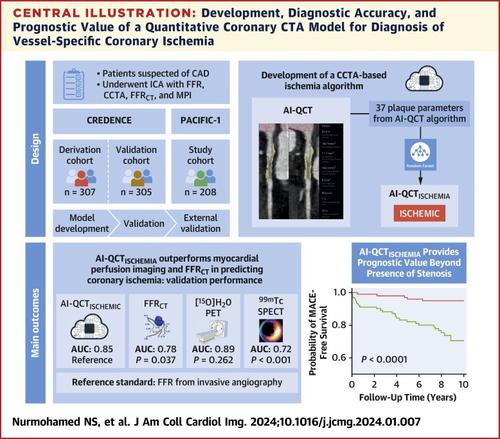当前位置:
X-MOL 学术
›
JACC Cardiovasc. Imaging
›
论文详情
Our official English website, www.x-mol.net, welcomes your
feedback! (Note: you will need to create a separate account there.)
Development and Validation of a Quantitative Coronary CT Angiography Model for Diagnosis of Vessel-Specific Coronary Ischemia
JACC: Cardiovascular Imaging ( IF 12.8 ) Pub Date : 2024-03-13 , DOI: 10.1016/j.jcmg.2024.01.007 Nick S Nurmohamed 1 , Ibrahim Danad 2 , Ruurt A Jukema 3 , Ruben W de Winter 3 , Robin J de Groot 3 , Roel S Driessen 3 , Michiel J Bom 3 , Pepijn van Diemen 3 , Gianluca Pontone 4 , Daniele Andreini 5 , Hyuk-Jae Chang 6 , Richard J Katz 7 , Erik S G Stroes 8 , Hao Wang 9 , Chung Chan 9 , Tami Crabtree 9 , Melissa Aquino 9 , James K Min 9 , James P Earls 10 , Jeroen J Bax 11 , Andrew D Choi 7 , Paul Knaapen 3 , Alexander R van Rosendael 11 ,
JACC: Cardiovascular Imaging ( IF 12.8 ) Pub Date : 2024-03-13 , DOI: 10.1016/j.jcmg.2024.01.007 Nick S Nurmohamed 1 , Ibrahim Danad 2 , Ruurt A Jukema 3 , Ruben W de Winter 3 , Robin J de Groot 3 , Roel S Driessen 3 , Michiel J Bom 3 , Pepijn van Diemen 3 , Gianluca Pontone 4 , Daniele Andreini 5 , Hyuk-Jae Chang 6 , Richard J Katz 7 , Erik S G Stroes 8 , Hao Wang 9 , Chung Chan 9 , Tami Crabtree 9 , Melissa Aquino 9 , James K Min 9 , James P Earls 10 , Jeroen J Bax 11 , Andrew D Choi 7 , Paul Knaapen 3 , Alexander R van Rosendael 11 ,
Affiliation

|
Noninvasive stress testing is commonly used for detection of coronary ischemia but possesses variable accuracy and may result in excessive health care costs. This study aimed to derive and validate an artificial intelligence-guided quantitative coronary computed tomography angiography (AI-QCT) model for the diagnosis of coronary ischemia that integrates atherosclerosis and vascular morphology measures (AI-QCT) and to evaluate its prognostic utility for major adverse cardiovascular events (MACE). A post hoc analysis of the CREDENCE (Computed Tomographic Evaluation of Atherosclerotic Determinants of Myocardial Ischemia) and PACIFIC-1 (Comparison of Coronary Computed Tomography Angiography, Single Photon Emission Computed Tomography [SPECT], Positron Emission Tomography [PET], and Hybrid Imaging for Diagnosis of Ischemic Heart Disease Determined by Fractional Flow Reserve) studies was performed. In both studies, symptomatic patients with suspected stable coronary artery disease had prospectively undergone coronary computed tomography angiography (CTA), myocardial perfusion imaging (MPI), SPECT, or PET, fractional flow reserve by CT (FFR), and invasive coronary angiography in conjunction with invasive FFR measurements. The AI-QCT model was developed in the derivation cohort of the CREDENCE study, and its diagnostic performance for coronary ischemia (FFR ≤0.80) was evaluated in the CREDENCE validation cohort and PACIFIC-1. Its prognostic value was investigated in PACIFIC-1. In CREDENCE validation (n = 305, age 64.4 ± 9.8 years, 210 [69%] male), the diagnostic performance by area under the receiver-operating characteristics curve (AUC) on per-patient level was 0.80 (95% CI: 0.75-0.85) for AI-QCT, 0.69 (95% CI: 0.63-0.74; 0.001) for FFR, and 0.65 (95% CI: 0.59-0.71; 0.001) for MPI. In PACIFIC-1 (n = 208, age 58.1 ± 8.7 years, 132 [63%] male), the AUCs were 0.85 (95% CI: 0.79-0.91) for AI-QCT, 0.78 (95% CI: 0.72-0.84; = 0.037) for FFR, 0.89 (95% CI: 0.84-0.93; 0.262) for PET, and 0.72 (95% CI: 0.67-0.78; 0.001) for SPECT. Adjusted for clinical risk factors and coronary CTA-determined obstructive stenosis, a positive AI-QCT test was associated with aHR: 7.6 (95% CI: 1.2-47.0; = 0.030) for MACE. This newly developed coronary CTA-based ischemia model using coronary atherosclerosis and vascular morphology characteristics accurately diagnoses coronary ischemia by invasive FFR and provides robust prognostic utility for MACE beyond presence of stenosis.
中文翻译:

用于血管特异性冠状动脉缺血诊断的定量冠状动脉 CT 血管造影模型的开发和验证
无创负荷试验通常用于检测冠状动脉缺血,但准确性参差不齐,并可能导致过高的医疗保健费用。本研究旨在推导和验证人工智能引导的定量冠状动脉断层扫描血管造影 (AI-QCT) 模型,用于诊断冠状动脉缺血,该模型结合了动脉粥样硬化和血管形态学测量 (AI-QCT),并评估其对主要不良心血管事件 (MACE) 的预后效用。对 CREDENCE (心肌缺血动脉粥样硬化决定因素的计算机断层扫描评估) 和 PACIFIC-1 (冠状动脉计算机断层扫描血管造影、单光子发射计算机断层扫描 [SPECT]、正电子发射断层扫描 [PET] 和混合成像诊断缺血性心脏病的比较)进行了事后分析通过血流储备分数确定的缺血性心脏病)研究。在这两项研究中,疑似稳定型冠状动脉疾病的有症状患者前瞻性地接受了冠状动脉计算机断层扫描血管造影 (CTA) 、心肌灌注成像 (MPI)、SPECT 或 PET、CT 血流储备分数 (FFR) 和有创冠状动脉造影联合有创 FFR 测量。AI-QCT 模型是在 CREDENCE 研究的衍生队列中开发的,其对冠状动脉缺血的诊断性能 (FFR ≤0.80) 在 CREDENCE 验证队列和 PACIFIC-1 中进行了评估。在 PACIFIC-1 中研究了其预后价值。在 CREDENCE 验证 (n = 305,年龄 64.4 ± 9.8 岁,210 [69%] 男性)中,按接受者作特征曲线下面积 (AUC) 划分的诊断性能在每位患者水平上为 0.80 (95% CI: 0.75-0.85) 对于 AI-QCT,0.69 (95% CI: 0.63-0.74;0.001) 对于 FFR,为 0.65 (95% CI: 0.59-0.71;0.001) 的 MPI 的 MPI 的 API 请求。在 PACIFIC-1 (n = 208,年龄 58.1 ± 8.7 岁,132 [63%] 男性)中,AI-QCT 的 AUC 为 0.85 (95% CI: 0.79-0.91),FFR 为 0.78 (95% CI: 0.72-0.84;= 0.037),PET 为 0.89 (95% CI: 0.84-0.93;0.262) 和 SPECT 为 0.72 (95% CI: 0.67-0.78;0.001)。根据临床危险因素和冠状动脉 CTA 确定的阻塞性狭窄进行调整,阳性 AI-QCT 检测与 aHR 相关:MACE 为 7.6 (95% CI: 1.2-47.0;= 0.030)。这种新开发的基于冠状动脉 CTA 的缺血模型使用冠状动脉粥样硬化和血管形态学特征,通过侵入性 FFR 准确诊断冠状动脉缺血,并为 MACE 提供超越狭窄的稳健预后效用。
更新日期:2024-03-13
中文翻译:

用于血管特异性冠状动脉缺血诊断的定量冠状动脉 CT 血管造影模型的开发和验证
无创负荷试验通常用于检测冠状动脉缺血,但准确性参差不齐,并可能导致过高的医疗保健费用。本研究旨在推导和验证人工智能引导的定量冠状动脉断层扫描血管造影 (AI-QCT) 模型,用于诊断冠状动脉缺血,该模型结合了动脉粥样硬化和血管形态学测量 (AI-QCT),并评估其对主要不良心血管事件 (MACE) 的预后效用。对 CREDENCE (心肌缺血动脉粥样硬化决定因素的计算机断层扫描评估) 和 PACIFIC-1 (冠状动脉计算机断层扫描血管造影、单光子发射计算机断层扫描 [SPECT]、正电子发射断层扫描 [PET] 和混合成像诊断缺血性心脏病的比较)进行了事后分析通过血流储备分数确定的缺血性心脏病)研究。在这两项研究中,疑似稳定型冠状动脉疾病的有症状患者前瞻性地接受了冠状动脉计算机断层扫描血管造影 (CTA) 、心肌灌注成像 (MPI)、SPECT 或 PET、CT 血流储备分数 (FFR) 和有创冠状动脉造影联合有创 FFR 测量。AI-QCT 模型是在 CREDENCE 研究的衍生队列中开发的,其对冠状动脉缺血的诊断性能 (FFR ≤0.80) 在 CREDENCE 验证队列和 PACIFIC-1 中进行了评估。在 PACIFIC-1 中研究了其预后价值。在 CREDENCE 验证 (n = 305,年龄 64.4 ± 9.8 岁,210 [69%] 男性)中,按接受者作特征曲线下面积 (AUC) 划分的诊断性能在每位患者水平上为 0.80 (95% CI: 0.75-0.85) 对于 AI-QCT,0.69 (95% CI: 0.63-0.74;0.001) 对于 FFR,为 0.65 (95% CI: 0.59-0.71;0.001) 的 MPI 的 MPI 的 API 请求。在 PACIFIC-1 (n = 208,年龄 58.1 ± 8.7 岁,132 [63%] 男性)中,AI-QCT 的 AUC 为 0.85 (95% CI: 0.79-0.91),FFR 为 0.78 (95% CI: 0.72-0.84;= 0.037),PET 为 0.89 (95% CI: 0.84-0.93;0.262) 和 SPECT 为 0.72 (95% CI: 0.67-0.78;0.001)。根据临床危险因素和冠状动脉 CTA 确定的阻塞性狭窄进行调整,阳性 AI-QCT 检测与 aHR 相关:MACE 为 7.6 (95% CI: 1.2-47.0;= 0.030)。这种新开发的基于冠状动脉 CTA 的缺血模型使用冠状动脉粥样硬化和血管形态学特征,通过侵入性 FFR 准确诊断冠状动脉缺血,并为 MACE 提供超越狭窄的稳健预后效用。

































 京公网安备 11010802027423号
京公网安备 11010802027423号